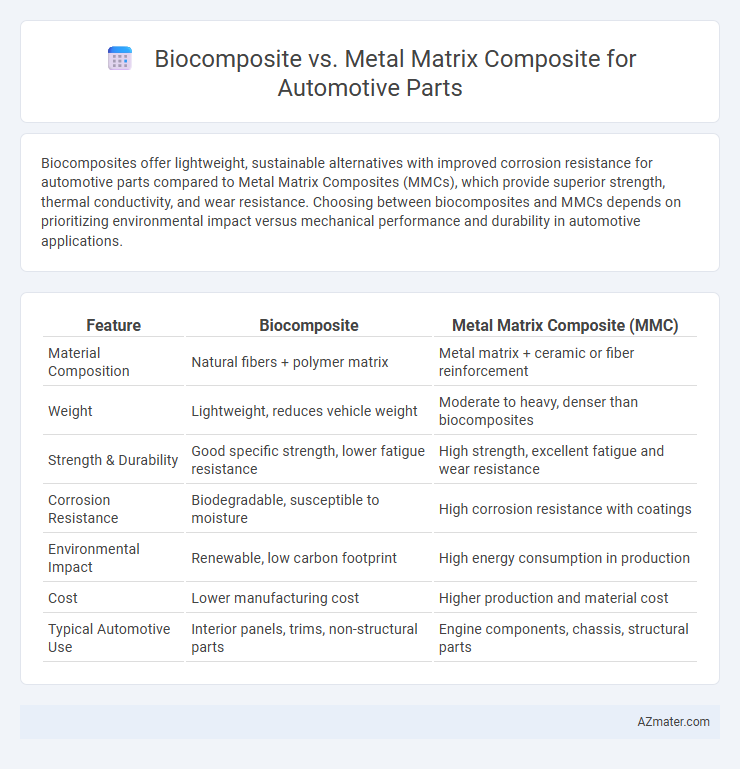Biocomposites offer lightweight, sustainable alternatives with improved corrosion resistance for automotive parts compared to Metal Matrix Composites (MMCs), which provide superior strength, thermal conductivity, and wear resistance. Choosing between biocomposites and MMCs depends on prioritizing environmental impact versus mechanical performance and durability in automotive applications.
Table of Comparison
| Feature | Biocomposite | Metal Matrix Composite (MMC) |
|---|---|---|
| Material Composition | Natural fibers + polymer matrix | Metal matrix + ceramic or fiber reinforcement |
| Weight | Lightweight, reduces vehicle weight | Moderate to heavy, denser than biocomposites |
| Strength & Durability | Good specific strength, lower fatigue resistance | High strength, excellent fatigue and wear resistance |
| Corrosion Resistance | Biodegradable, susceptible to moisture | High corrosion resistance with coatings |
| Environmental Impact | Renewable, low carbon footprint | High energy consumption in production |
| Cost | Lower manufacturing cost | Higher production and material cost |
| Typical Automotive Use | Interior panels, trims, non-structural parts | Engine components, chassis, structural parts |
Introduction to Automotive Composite Materials
Automotive composite materials combine different substances to enhance performance, with biocomposites using natural fibers and resins, offering lightweight, renewable, and biodegradable alternatives. Metal matrix composites (MMCs) consist of metal combined with ceramic or other reinforcements, delivering superior strength, thermal stability, and wear resistance for high-performance automotive components. Selection between biocomposite and MMC depends on balancing factors like environmental impact, mechanical properties, cost, and application-specific durability.
Key Properties of Biocomposites
Biocomposites used in automotive parts offer high strength-to-weight ratios, excellent corrosion resistance, and enhanced biodegradability compared to traditional Metal Matrix Composites (MMCs). Their key properties include low density for improved fuel efficiency, good impact resistance, and superior vibration damping, which contribute to quieter and smoother vehicle performance. Biocomposites also provide environmental benefits through reduced carbon footprint and easier recyclability, making them increasingly preferred in sustainable automotive manufacturing.
Key Properties of Metal Matrix Composites
Metal Matrix Composites (MMCs) exhibit superior mechanical strength, high thermal conductivity, and excellent wear resistance, making them ideal for demanding automotive parts like engine components and brake systems. Their low density combined with enhanced stiffness provides significant weight reduction without compromising durability, contributing to improved fuel efficiency. MMCs also offer exceptional corrosion resistance and thermal stability, enabling reliable performance under extreme operating conditions.
Weight Reduction Potential: Biocomposites vs MMCs
Biocomposites offer significant weight reduction potential for automotive parts due to their low density, typically around 1.2 g/cm3, compared to metal matrix composites (MMCs) which have densities ranging from 2.5 to 3.5 g/cm3. This reduction translates to improved fuel efficiency and lower emissions by decreasing overall vehicle weight. Despite MMCs providing superior mechanical strength and thermal stability, biocomposites excel in weight-sensitive applications where lightweight and sustainability are prioritized.
Mechanical Strength Comparison
Biocomposites typically offer lower mechanical strength compared to metal matrix composites (MMCs), which exhibit superior tensile strength, hardness, and fatigue resistance essential for high-performance automotive parts. MMCs combine lightweight metal alloys with reinforcing materials like ceramics or carbon fibers, resulting in enhanced stiffness and durability under dynamic loading conditions. Biocomposites, while environmentally sustainable, generally lack the rigidity and load-bearing capacity required for critical structural components in automotive applications.
Thermal Stability and Heat Resistance
Biocomposites exhibit lower thermal stability and heat resistance compared to metal matrix composites (MMCs), limiting their use in high-temperature automotive applications. MMCs, typically reinforced with ceramic particles or fibers, offer superior thermal conductivity and maintain structural integrity at elevated temperatures up to 600degC or higher. The enhanced heat resistance of MMCs makes them preferable for engine components and brake systems where thermal loads are critical.
Environmental Impact and Sustainability
Biocomposites in automotive parts significantly reduce environmental impact due to their biodegradability and lower carbon footprint compared to traditional metal matrix composites, which require energy-intensive extraction and processing. The renewable nature of biocomposites contributes to sustainability by minimizing reliance on non-renewable resources and enhancing end-of-life recyclability. Conversely, metal matrix composites offer superior mechanical properties but pose challenges in resource depletion and environmental pollution during manufacturing and disposal stages.
Cost Analysis: Manufacturing and Lifecycle
Biocomposites offer lower manufacturing costs due to renewable raw materials and energy-efficient processing compared to metal matrix composites (MMCs), which require high-temperature alloying and machining. Lifecycle cost analysis reveals biocomposites reduce expenses through lighter weight, leading to improved fuel efficiency and decreased emissions, while MMCs provide superior mechanical performance but often incur higher maintenance and recycling costs. Cost-benefit evaluations favor biocomposites for sustainable, lightweight automotive parts, whereas MMCs suit high-performance applications demanding durability under extreme conditions.
Application Suitability in Automotive Components
Biocomposites offer lightweight, corrosion-resistant properties ideal for interior automotive components such as door panels and dashboards, enhancing fuel efficiency and sustainability. Metal matrix composites (MMCs) provide superior strength, wear resistance, and thermal stability, making them suitable for engine parts, brake systems, and structural components requiring high mechanical performance. The choice between biocomposites and MMCs depends on application-specific demands for weight reduction, durability, and operating conditions in automotive manufacturing.
Future Trends and Innovations in Automotive Composites
Biocomposites for automotive parts are gaining traction due to their lightweight, renewable nature, and lower carbon footprint, promising enhanced sustainability in vehicle manufacturing. Metal matrix composites (MMCs) continue to evolve with innovations in nano-reinforcements and hybrid matrix systems, delivering superior strength, heat resistance, and durability critical for high-performance automotive components. Future trends indicate increased integration of biocomposites with MMCs in hybrid materials, leveraging the environmental benefits of natural fibers alongside the mechanical advantages of metals to optimize weight reduction and performance in next-generation automotive designs.

Infographic: Biocomposite vs Metal Matrix Composite for Automotive Part
 azmater.com
azmater.com